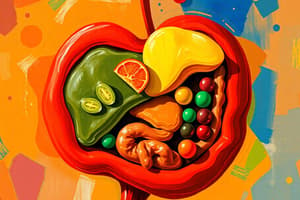Podcast
Questions and Answers
What are glucogenic amino acids primarily used for?
What are glucogenic amino acids primarily used for?
- To synthesize exclusively non-essential amino acids
- To form urea and ammonia
- To yield pyruvate or intermediates of the citric acid cycle (correct)
- To directly produce ketone bodies
Which amino acids are classified as exclusively ketogenic?
Which amino acids are classified as exclusively ketogenic?
- Leucine and lysine (correct)
- Phenylalanine and tyrosine
- Alanine and glutamine
- Valine and isoleucine
How do ketogenic amino acids differ from glucogenic amino acids?
How do ketogenic amino acids differ from glucogenic amino acids?
- Their catabolism yields ketone bodies (correct)
- They can directly produce glucose in the liver
- They are not involved in energy production
- They yield glucose instead of ketones
What is the primary end product of amino acid catabolism for glucogenic amino acids?
What is the primary end product of amino acid catabolism for glucogenic amino acids?
Which of the following processes does not involve glucogenic amino acids?
Which of the following processes does not involve glucogenic amino acids?
Which compounds are formed from the catabolism of amino acids in the ketosis process?
Which compounds are formed from the catabolism of amino acids in the ketosis process?
What role do amino acids play in the synthesis of non-essential amino acids?
What role do amino acids play in the synthesis of non-essential amino acids?
The carbon skeletons of which amino acids cannot enter gluconeogenesis?
The carbon skeletons of which amino acids cannot enter gluconeogenesis?
What is the primary consequence of hyperammonemia on the brain?
What is the primary consequence of hyperammonemia on the brain?
Where does the formation of urea primarily occur in the body?
Where does the formation of urea primarily occur in the body?
What is the primary role of enteropeptidase in protein digestion?
What is the primary role of enteropeptidase in protein digestion?
Which component is produced in the mitochondria during the urea cycle?
Which component is produced in the mitochondria during the urea cycle?
What constitutes a positive nitrogen balance in the body?
What constitutes a positive nitrogen balance in the body?
What happens to ammonia levels in cases of compromised liver function?
What happens to ammonia levels in cases of compromised liver function?
Which of the following is NOT a factor associated with negative nitrogen balance?
Which of the following is NOT a factor associated with negative nitrogen balance?
What percentage of the amino group disposal occurs through the urea cycle?
What percentage of the amino group disposal occurs through the urea cycle?
Which of the following describes a function of urea in the body?
Which of the following describes a function of urea in the body?
Which enzymes are primarily involved in protein digestion in the small intestine?
Which enzymes are primarily involved in protein digestion in the small intestine?
What primarily happens to amino acids after they are absorbed?
What primarily happens to amino acids after they are absorbed?
What is the primary effect of ammonia on the central nervous system?
What is the primary effect of ammonia on the central nervous system?
What is nitrogen equilibrium?
What is nitrogen equilibrium?
Which intermediate is essential in the citric acid cycle and is affected by hyperammonemia?
Which intermediate is essential in the citric acid cycle and is affected by hyperammonemia?
In which condition is a negative nitrogen balance most likely to occur?
In which condition is a negative nitrogen balance most likely to occur?
Which route is NOT typically associated with nitrogen excretion?
Which route is NOT typically associated with nitrogen excretion?
What are the enzymes that catalyze transamination reactions commonly called?
What are the enzymes that catalyze transamination reactions commonly called?
What does the presence of elevated plasma aminotransferases primarily indicate?
What does the presence of elevated plasma aminotransferases primarily indicate?
Which amino acid is primarily formed during transamination reactions involving alanine?
Which amino acid is primarily formed during transamination reactions involving alanine?
In which organ are aminotransferases especially abundant?
In which organ are aminotransferases especially abundant?
Which aminotransferases are particularly noted for their diagnostic value?
Which aminotransferases are particularly noted for their diagnostic value?
In which condition are aminotransferases likely to be most elevated?
In which condition are aminotransferases likely to be most elevated?
What is the primary role of aspartate aminotransferase (AST) in amino acid metabolism?
What is the primary role of aspartate aminotransferase (AST) in amino acid metabolism?
What primary transport mechanism for ammonia is used by muscle?
What primary transport mechanism for ammonia is used by muscle?
What is the common reaction characteristic of aminotransferases?
What is the common reaction characteristic of aminotransferases?
What is the role of glutaminase in the ammonia transport process?
What is the role of glutaminase in the ammonia transport process?
In transamination involving pyruvic acid and α-ketoglutaric acid, which new product is formed?
In transamination involving pyruvic acid and α-ketoglutaric acid, which new product is formed?
What is one outcome of ammonia toxicity in the body?
What is one outcome of ammonia toxicity in the body?
What does a low level of aminotransferases in plasma typically signify?
What does a low level of aminotransferases in plasma typically signify?
Which α-keto acid is frequently associated with the transamination reactions involving alanine?
Which α-keto acid is frequently associated with the transamination reactions involving alanine?
Which cycle involves the conversion of alanine back to pyruvate in the liver?
Which cycle involves the conversion of alanine back to pyruvate in the liver?
What is NOT a condition associated with elevated aminotransferases?
What is NOT a condition associated with elevated aminotransferases?
Flashcards are hidden until you start studying
Study Notes
Overall Protein Metabolism
- The body breaks down proteins into amino acids, which are then used for various purposes, including energy production, synthesis of new proteins, and production of other compounds.
- Dietary protein is digested in the stomach and small intestine by proteolytic enzymes, producing amino acids.
- Amino acids can be either glucogenic or ketogenic.
- Glucogenic amino acids are broken down into intermediates that can be used for gluconeogenesis, the production of glucose.
- Ketogenic amino acids are broken down into acetyl CoA and acetoacetyl CoA, which are used for ketogenesis, the production of ketone bodies.
- Nitrogen balance is the difference between nitrogen intake and output.
- Positive nitrogen balance occurs during growth, pregnancy, and muscular training.
- Negative nitrogen balance occurs during starvation, malnutrition, gastrointestinal diseases, chronic hemorrhage, and increased protein catabolism.
- Transamination reactions are catalyzed by aminotransferases, which transfer amino groups from an α-amino acid to an α-keto acid.
- Alanine aminotransferase (ALT) transfers amino groups from alanine to α-ketoglutarate, producing pyruvate and glutamate.
- Aspartate aminotransferase (AST) transfers amino groups from glutamate to oxaloacetate, producing aspartate and α-ketoglutarate.
Diagnostic Value of Plasma Aminotransferases
- Elevated plasma levels of aminotransferases indicate damage to cells rich in these enzymes.
- Elevated AST and ALT are observed in liver diseases, such as hepatitis, toxic injury, and circulatory collapse.
- Elevated aminotransferases can also be found in nonhepatic diseases, such as myocardial infarction and muscle disorders.
Transport of Ammonia to the Liver
- Ammonia is a toxic byproduct of amino acid metabolism.
- Two mechanisms are used to transport ammonia to the liver:
- Glutamine synthesis combines ammonia with glutamate to form glutamine, a nontoxic transport form. Glutamine is then transported to the liver and cleaved by glutaminase to produce glutamate and ammonia.
- Glucose-alanine Cycle: Muscle transaminates pyruvate to form alanine, which is transported to the liver and converted back to pyruvate. The pyruvate can be used for gluconeogenesis.
Ammonia Toxicity
- Ammonia toxicity can result from a shift in the equilibrium of the glutamate dehydrogenase reaction, depleting α-ketoglutarate, an essential intermediate in the citric acid cycle. This leads to a decrease in ATP production.
- The brain is particularly sensitive to hyperammonemia, as it relies on the citric acid cycle for energy production.
Urea Cycle
- The urea cycle is the principal pathway for ammonia disposal.
- The cycle occurs primarily in the liver, with the first two reactions taking place in the mitochondria and the remaining three reactions occurring in the cytosol.
- Urea, the end product of the urea cycle, is excreted by the kidneys.
Hyperammonemia
- Hyperammonemia is a medical emergency due to the neurotoxic effects of ammonia.
- Causes of hyperammonemia include genetic defects in the urea cycle and liver disease.
Studying That Suits You
Use AI to generate personalized quizzes and flashcards to suit your learning preferences.




